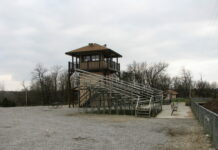Photo credit: DiasporaEngager (www.DiasporaEngager.com).
Law enforcement wants more drones, and we’ll probably see many more of them overhead as police departments seek to implement a popular project justifying the deployment of unmanned aerial vehicles (UAVs): the “drone as first responder” (DFR).
Police DFR programs involve a fleet of drones, which can range in number from four or five to hundreds. In response to 911 calls and other law enforcement calls for service, a camera-equipped drone is launched from a regular base (like the police station roof) to get to the incident first, giving responding officers a view of the scene before they arrive. In theory and in marketing materials, the advance view from the drone will help officers understand the situation more thoroughly before they get there, better preparing them for the scene and assisting them in things such as locating wanted or missing individuals more quickly. Police call this “situational awareness.”
In practice, law enforcement’s desire to get “a view of the scene” becomes a justification for over-surveilling neighborhoods that produce more 911 calls and for collecting information on anyone who happens to be in the drone’s path. For example, a drone responding to a vandalism case may capture video footage of everyone it passes along the way. Also, drones are subject to the same mission-creep issues that already plague other police tools designed to record the public; what is pitched as a solution to violent crime can quickly become a tool for policing homelessness or low-level infractions that otherwise wouldn’t merit police resources.
With their birds-eye view, drones can observe individuals in previously private and constitutionally protected spaces, like their backyards, roofs, and even through home windows. And they can capture crowds of people, like protestors and other peaceful gatherers exercising their First Amendment rights. Drones can be equipped with cameras, thermal imaging, microphones, license plate readers, face recognition, mapping technology, cell-site simulators, weapons, and other payloads. Proliferation of these devices enables state surveillance even for routine operations and in response to innocuous calls —situations unrelated to the original concerns of terrorism or violent crime originally used to justify their adoption.
Drones are also increasingly tied into other forms of surveillance. More departments — including those in Las Vegas, Louisville, and New York City — are toying with the idea of dispatching drones in response to ShotSpotter gunshot detection alerts, which are known to send many false positive alerts. This could lead to drone surveillance of communities that happen to have a higher concentration of ShotSpotter microphones or other acoustic gunshot detection technology. Data revealed recently shows that a disproportionate number of these gunshot detection sensors are located in Black communities in the United States. Also, artificial intelligence is also being added to drone data collection; connecting what’s gathered from the sky to what has been gathered on the street and through other methods is a trending part of the police panopticon plan.
A CVPD official explains the DFR program to EFF staff in 2022. Credit: Jason Kelley (EFF)
DFR programs have been growing in popularity since first launched by the Chula Vista Police Department in 2018. Now there are a few dozen departments with known DFR programs among the approximately 1,500 police departments known to have any drone program at all, according to EFF’s Atlas of Surveillance, the most comprehensive dataset of this kind of information. The Federal Aviation Administration (FAA) regulates use of drones and is currently mandated to prepare new regulations for how they can be operated beyond the operator’s line of sight (BVLOS), the kind of long-distance flight that currently requires a special waiver. All the while, police departments and the companies that sell drones are eager to move forward with more DFR initiatives.
Transparency around the acquisition and use of drones will be important to the effort to protect civilians from government and police overreach and abuse as agencies commission more of these flying machines. A recent Wired investigation raised concerns about Chula Vista’s program, finding that roughly one in 10 drone flights lacked a stated purpose, and for nearly 500 of its recent flights, the reason for deployment was an “unknown problem.” That same investigation also found that each average drone flight exposes nearly 5,000 city residents to enhanced surveillance, primarily in predominantly Black and brown neighborhoods.
“For residents we spoke to,” Wired wrote, “the discrepancy raises serious concerns about the accuracy and reliability of the department’s transparency efforts—and experts say the use of the drones is a classic case of self-perpetuating mission creep, with their existence both justifying and necessitating their use.”
Chula Vista’s “Drone-Related Activity Dashboard” indicates that more than 20 percent of drone flights are welfare checks or mental health crises, while only roughly 6% are responding to assault calls. Chula Vista Police claim that the DFR program lets them avoid potentially dangerous or deadly interactions with members of the public, with drone responses resulting in their department avoiding sending a patrol unit in response to 4,303 calls. However, this theory and the supporting data needs to be meaningfully evaluated by independent researchers.
This type of analysis is not possible without transparency around the program in Chula Vista, which, to its credit, publishes regular details like the location and reason for each of its deployments. Still, that department has also tried to prevent the public from learning about its program, rejecting California Public Records Act (CPRA) requests for drone footage. This led to a lawsuit in which EFF submitted an amicus brief, and ultimately the California Court of Appeal correctly found that drone footage is not exempt from CPRA requests.
While some might take for granted that the government is not allowed to conduct surveillance — intentional, incidental, or otherwise — on you in spaces like your fenced-in backyard, this is not always the case. It took a lawsuit and a recent Alaska Supreme Court decision to ensure that police in that state must obtain a warrant for drone surveillance in otherwise private areas. While some states do require a warrant to use a drone to violate the privacy of a person’s airspace, Alaska, California, Hawaii, and Vermont are currently the only states where courts have held that warrantless aerial surveillance violates residents’ constitutional protections against unreasonable search and seizure absent specific exceptions.
Clear policies around the use of drones are a valuable part of holding police departments accountable for their drone use. These policies must include rules around why a drone is deployed and guardrails on the kind of footage that is collected, the length of time it is retained, and with whom it can be shared.
A few state legislatures have taken some steps toward providing some public accountability over growing drone use.
- In Minnesota, law enforcement agencies are required to annually report their drone programs’ costs and the number of times they deployed drones with, including how many times they were deployed without a warrant.
- In Illinois, the Drones as First Responders Act went into effect June 2023, requiring agencies to report whether they own drones; how many are owned; the number of times the drones were deployed, as well as the date, location, and reason for the deployment; and whether video was captured and then retained from each deployment. Illinois agencies also must share a copy of their latest use policies, drone footage is generally supposed to be deleted after 24 hours, and the use of face recognition technology is prohibited except in certain circumstances.
- In California, AB 481 — which took effect in May 2022 with the aim of providing public oversight over military-grade police equipment — requires police departments to publicly share a regular inventory of the drones that they use. Under this law, police acquisition of drones and the policies governing their use require approval from local elected officials following an opportunity for public comment, giving communities an important chance to provide feedback.
DFR programs are just one way police are acquiring drones, but law enforcement and UAV manufacturers are interested in adding drones in other ways, including as part of regular patrols and in response to high-speed vehicle pursuits. These uses also create the risk of law enforcement bypassing important safeguards. Reasonable protections for public privacy, like robust use policies, are not a barrier to public safety but a crucial part of ensuring just and constitutional policing.
Companies are eager to tap this growing market. Police technology company Axon —known for its Tasers and body-worn cameras — recently acquired drone company Dedrone, specifically citing that company’s efforts to push DFR programs as one reason for the acquisition. Axon since has established a partnership with Skydio in order to expand their DFR sales.
It’s clear that as the skies open up for more drone usage, law enforcement will push to procure more of these flying surveillance tools. But police and lawmakers must exercise far more skepticism over what may ultimately prove to be a flashy trend that wastes resources, infringes on people’s rights, and results in unforeseen shifts in policing strategy. The public must be kept aware of how cops are coming for their privacy from above.
Source of original article: Electronic Frontier Foundation (EFF) / Deeplinks (www.eff.org).
The content of this article does not necessarily reflect the views or opinion of Global Diaspora News (www.GlobalDiasporaNews.com).
To submit your press release: (https://www.GlobalDiasporaNews.com/pr).
To advertise on Global Diaspora News: (www.GlobalDiasporaNews.com/ads).
Sign up to Global Diaspora News newsletter (https://www.GlobalDiasporaNews.com/newsletter/) to start receiving updates and opportunities directly in your email inbox for free.

































